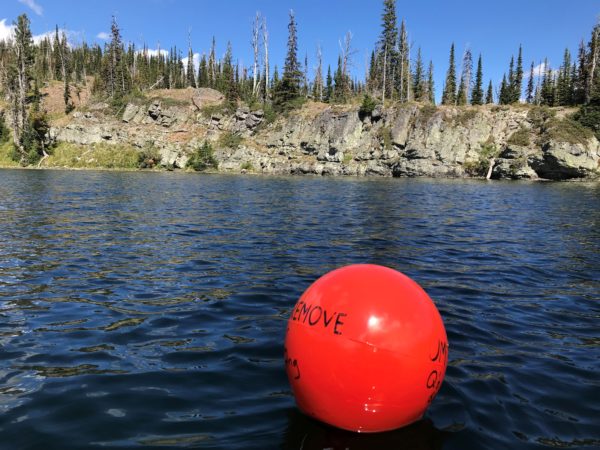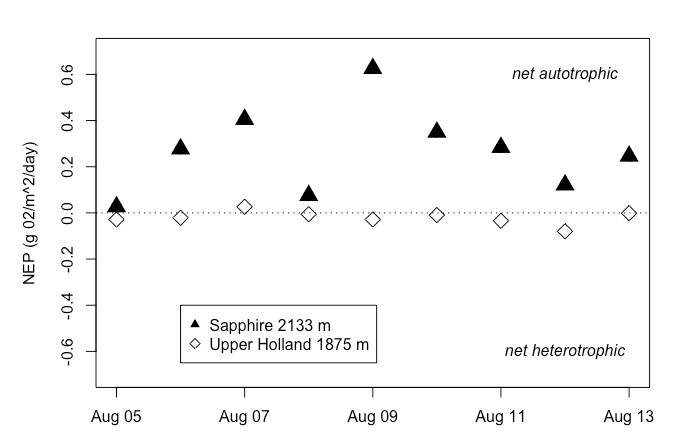
Water Column Investigation at Kauai Sea Farm
June 19, 2020
Recording Dissolved Oxygen Levels at Spawning Site of Invasive Trout Species
October 1, 2020miniDOT Logger Compares Nutrient Utilization and Cycles of Lakes
Project Details
- PRODUCT(S): miniDOT® Logger
- APPLICATION: Surface Water
- PARAMETER: Dissolved Oxygen, Temperature
- LOCATION: Sapphire Lake and Upper Holland Lake, Montana
- ORGANIZATION: University of Montana
- RECOGNITION: Joe Vanderwall

Case Study Description
Elevation greatly affects the ecosystem metabolism of lakes. The lack of nutrients such as carbon, nitrogen, and phosphorus at greater elevations cause the aquatic ecosystems to process them differently than comparable ecosystems at lower elevations. Much like human metabolisms, ecosystem metabolisms are the rate at which nutrients, like those mentioned above, are processed. However, the metabolism of an ecosystem, such as a lake, also determines whether the lake is a carbon source or a carbon sink. Joe Vanderwall, a graduate student at the University of Montana, aimed to measure the difference in nutrient utilization and cycles in high elevation lakes and medium elevation lakes.
Measuring Daily Dissolved Oxygen Levels
Vanderwall used a miniDOT Logger, HOBO temperature pendants, and a Meter Atmos-22 windspeed sensor to record data. The goal of the experiment was to find and record daily patterns of Dissolved Oxygen (DO) levels in a high elevation lake and use the data to estimate the primary production and ecosystem respiration of the lake.
The higher elevation lake was expected to be more autotrophic than the medium elevation lake due to the higher reliance on photosynthesis for nutrients at higher elevations. The windspeed sensor and temperature pendants helped the researchers account for outside influences that may change the oxygen levels in the water. By understanding and removing the physical processes that effect DO levels from the equation, Vanderwall could then estimate the biological processes (or metabolism) of the lake.
DO Measurements from Sapphire Lake and Upper Holland Lake
The high elevation lake used in this study was Sapphire Lake (7,000 ft) and the medium elevation lake data was taken from Upper Holland Lake (6,000 ft). The data was collected from these Montana lakes over the course of an entire summer, with Vanderwall downloading the data from the sensors every two weeks. Even after being submerged and collecting data for several months, Vanderwall said the miniDOT Logger experienced little to no fouling, even without an anti-fouling device. The miniDOT Logger was placed 1 meter underwater, where the most photosynthesis occurs, and recorded a data point every 10 minutes throughout the duration of the study.
The figure below shows the net ecosystem production (NEP) of the two lakes over time. The NEP is the balance of photosynthesis and respiration within the lake which shows how much carbon the lake is either producing or absorbing. A positive NEP means that the lake is producing more carbon than it is absorbing, making it autotrophic. Upper Holland’s data stays close to the 0 line while Sapphire Lake’s data is entirely on the positive NEP side of the chart, with a much higher degree of variation than seen in the lower elevation lake.

Conclusion
The experiment’s findings were consistent with Vanderwall’s hypothesis that the higher elevation lake would be more autotrophic than the medium elevation lake. As shown by the data, higher elevation lakes rely heavily on photosynthesis which affects their ecosystems and metabolisms in a way that medium and low elevation lakes aren’t affected. This means that the higher elevation lakes are producing more carbon than they are consuming, which gives Vanderwall an insight into the lake as an ecosystem, since carbon levels affect aquatic life and biological processes.
Product Description
The miniDOT® Logger is a completely submersible instrument that logs dissolved oxygen and temperature measurements. The oxygen sensor is an optode that measures dissolved oxygen concentration in water through a fluorescence method. Data are recorded to an internal SD card. Operation of the miniDOT Logger such as setting the time and sample interval can be accomplished via the USB cable.
Reach out to the PME team to learn how a miniDOT Logger can assist you in your next research project.

